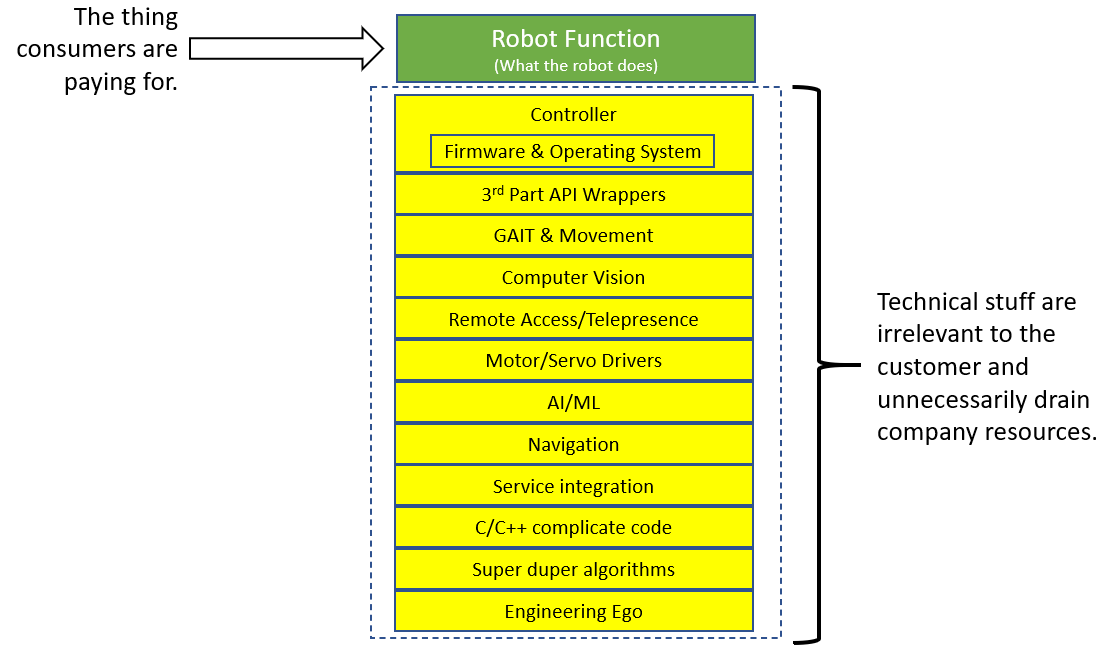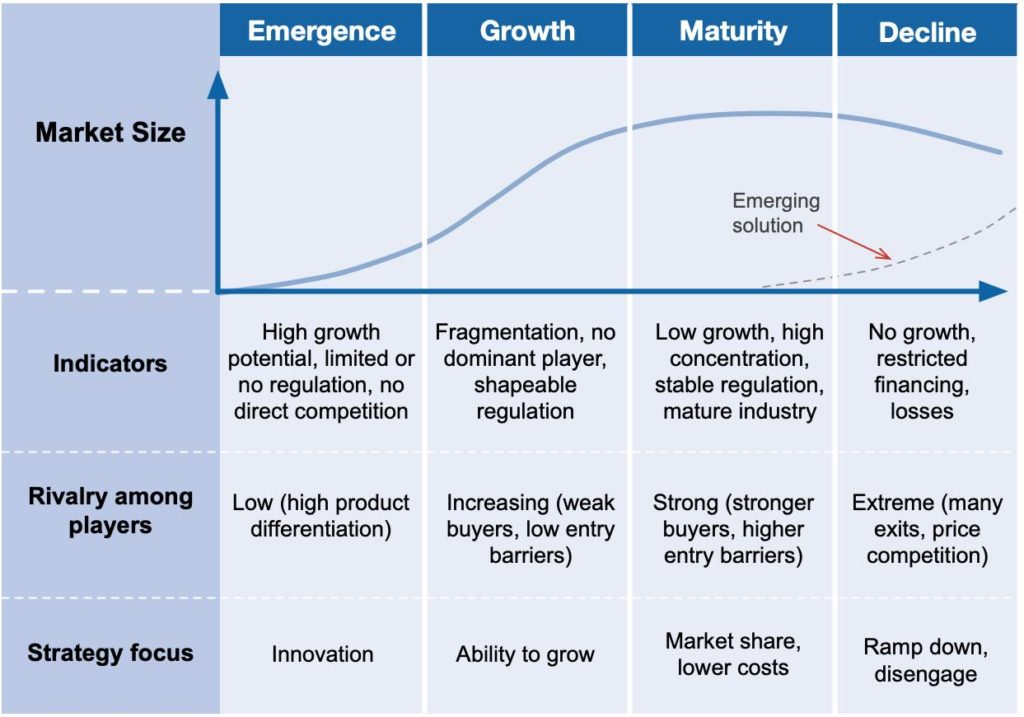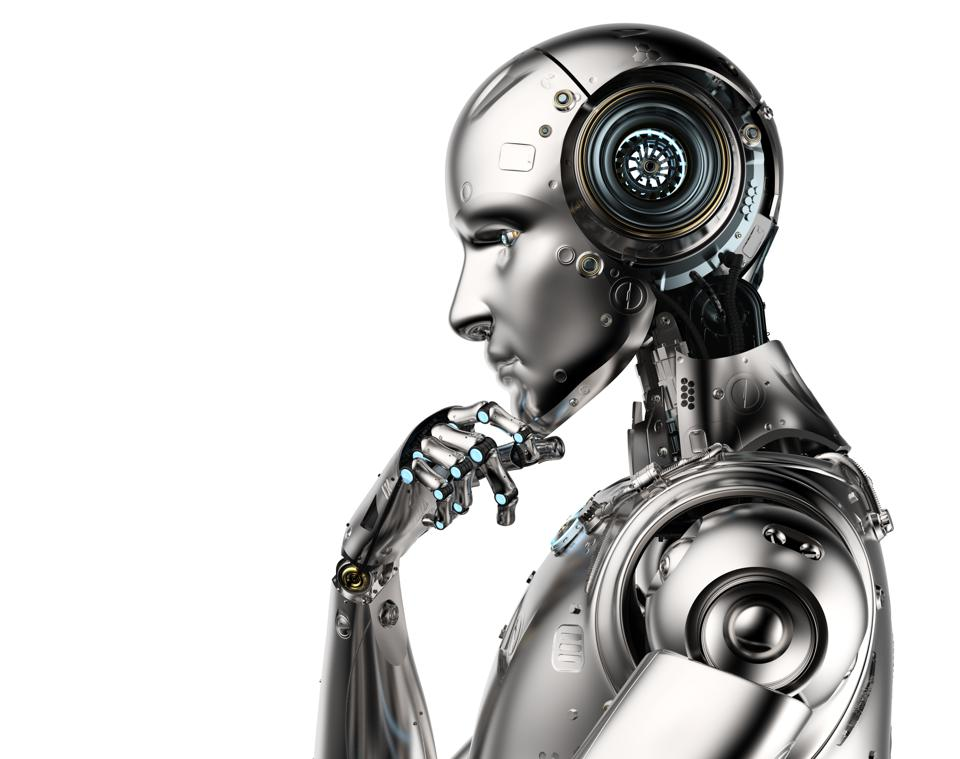
RIP: Anki, Jibo, Baxter, Mayfield, etc...
History foretells the fate of robot companies that attempt the burden of building and sustaining "the full-stack." Similar outcomes have affected companies from all industries where the founding partners were engineers. Today, we begin to ponder the question of where are the robots? Most importantly, why have so many robot companies failed, and what can we do to help robot companies succeed?

Perhaps the noise from social media, politics, and the current Covid-19 situation has caused startups and the investment community to forget a vital part of the industry life cycle stages. Organizations might have also overlooked this because it has also been several years since a new industry has emerged. Even the last few personal-computer sub-industries of mobile devices/apps, VR/AR, etc., have inherited sectors from existing mature and proven industries.

Robotics is a unique industry, albeit not too different from the personal-computer evolution, where multiple disciplines united to form a consumer product. The Personal Computer took many decades to influence and support sub-industries of software, hardware peripherals, and a wide range of use cases. Today, a computing device is user-friendly and esthetically pleasing, and the complex engineering disciplines are well hidden (CPU, operating system, drivers, power management, etc.). Readers may recall early personal-computer diagrams that included input, output, processing, and storage devices. Even earlier than the 1980's personal-computer, a computer consisted of even more complicated engineering disciplines that seemed impossible to scale to what we have today. Today, a computing device is common-place, and the components that make up computing devices are not taught in school as they once were.
The Revolution of Robot Platforms
Today, a child can operate a computing device before knowing how to speak. This results from a mature industry in which every contributor plays their strength by focusing on what they do best when contributing to product development. For example, some profitable companies make integrated circuits with a single function of performing mathematical floating-point calculations incredibly fast; because that is their strength. Another company will manufacturer a button or connector because that is their strength. Again, another produces batteries because it is their strength. The distribution of these disciplines in computing is how organizations can build platforms like Unity, Android, and Wix. Creative entrepreneurs use these platforms to make products that seamlessly integrate with our lives as tools and entertainment. What will it take for the robotics industry to distribute disciplines across specialists and enable creative entrepreneurs to make robot products rather than engineers? Imagine the impact that robot products made by creative entrepreneurs would have on our lives!
So, Where Is My Robot?
 This is the first blog entry in a series titled "Where Is My Robot?". We will cover the robot industry failures, strengths, and areas of improvement needed to fulfill consumer and financial potential. We will reflect on the fallen venture-backed giants that attempted to skip the industry life-cycle steps, such as Baxter, Anki, Jibo, Mayfield, Romo, and many others.
This is the first blog entry in a series titled "Where Is My Robot?". We will cover the robot industry failures, strengths, and areas of improvement needed to fulfill consumer and financial potential. We will reflect on the fallen venture-backed giants that attempted to skip the industry life-cycle steps, such as Baxter, Anki, Jibo, Mayfield, Romo, and many others.
We will examine organizations that repeat Synthiam's message that "too many robot companies focus on the robot and not the business"; however, these same organizations build complex solutions targeted at engineers instead of creative entrepreneurs. In this article by TechCrunch, hardware manufacturers use Synthiam's message that "making robots should be easy" while contrarily designing products targeted at engineers.
In this "Where Is My Robot?" series, other subjects we will discuss are operating system choices that support rapid prototyping for creative entrepreneurs. Most importantly, how using Linux for r&d increases the barrier of entry, adds unneeded operational complexities, and limits productive creativity.
Provide feedback in the comments of topics in this area you would like to see covered. See you in the next blog entry - stay tuned!

@DJ Of course, failure can't equal success, but failure can equal progress.
I don't think I mentioned anything about success, in my mind popularity, pioneering, and market adoption equal progress.
In terms of cobots, it's not an article that I've read. It's a fact that they are being used now and all the major robot arm players are making their own lines of cobots now. The concept that ReThink robotics helped pioneer with Baxter is now becoming industry standard.
Progress must equal success - and to be successful, you cannot own the full stack. I recommend scrolling up and reading this first entry of my blog series. None of the companies will be successful businesses if they’re repeating the same process.
Doing the same thing over and over again won’t result in a different outcome. These companies keep adding more rocks to their sinking ships and saying "we’ll be fine this time, we have twice as many rocks as before"
The Robot Report has an motive to have a positive spin on anything robot related. Just because they write about a company, doesn’t mean it will be successful. If that were the case, this blog series wouldn’t exist.
The great news about this conversation is your perspective as an engineer validates my point. I think it’s easy for engineers to understand that a business needs to make money - but it’s difficult for them to understand how to make money.
In addition to what was stated in the blog post above, even large companies are making these terrible engineering decisions about full stack. I provided a link to see one example - many more examples will come in upcoming posts in this series.
the fact is, someone like Will who makes products on a platform have a lower burn rate and higher resilience to succeed than even the largest venture-backed companies. Hence the RIP introduction.
What I'm trying to get across isn't saying anything against the idea of this blog post, it's exploring something that is absent from it.
It seems that the post is discrediting robot companies based on their success and short life-cycle.
I would argue that they have helped our industry progress, and for that, they do deserve some credit.
I'm open to understanding more about that perspective, but I don't see any validation on that front. Robots are doing the same thing today as they were 10, 20, and 30 years ago - which is 100% a negative outcome. How has the industry changed based on any failed robot companies?
Are we talking about hobby robots, cheap or expensive or household robots like iRobot, social robots, programed Alexa, Cortana etc... or commercial robots in whatever field like manufacturing, space, medical worlds etc...?
I did mention an example of cobots, which weren't really a thing until ReThink invented Baxter. There's validation there.
Here's what's happening now: https://aijourn.com/cobot-companies/ (Check out the individual company websites to see their new lines of cobots)
I don't remember hearing/reading anything about social robots when I was young. The first I heard about was Kismet, and then years later Jibo was made (by the same person). Jibo was the biggest grossing Indiegogo crowdfunding campaign of its time, and for that, it earns a place in history. It also had people around me talking about social robots that didn't normally talk about robots at all.
Maybe I'm unique, I also equate historical significance, new applications, and general robot awareness as progress.
Again, doing the same thing that leads to the failure of countless robot companies isn't validation or demonstration of progress. I'm asking because I don't see how those are examples of progress. Forgive me for sounding a little like a broken record, but can you provide an example of the progress that failed robot companies has provided the industry?
The only place Jibo belongs in history is how they duped people out of their hard-earned money. From the beginning, it was on a clear course for failure - which I had mentioned on this forum in the past. I don't see how any failures are significant enough to be noteworthy unless they influenced a success. To this date, there are too many failures from executing the same process. With your argument, any robot failure is progress because they're all taking the same approach?
Regarding social robots, I'm curious what you think a social robot does and why would someone want one?
What doesn't matter to me are failures - they demonstrate what not to do. So don't do what all robot companies are currently doing . Instead, build a robot product on a platform like Synthiam and let creative entrepreneurs build products that solve real-world problems. Rather than making up problems like "social robots" are doing - and they're doing it with costly full-stack development to make it worse.
. Instead, build a robot product on a platform like Synthiam and let creative entrepreneurs build products that solve real-world problems. Rather than making up problems like "social robots" are doing - and they're doing it with costly full-stack development to make it worse.
@EZANG, there are no robots outside of hobby robots. Don't let The Robot Report or any marketing fool you otherwise. If there were robots outside of hobby robots, you'd see them at Walmart. Walmart will put anything on a shelf that sells - that's your validation.
lol, not to many things fool me at this point
I read Jeremie's site, A cobot, or collaborative robot, sound commercial - maybe something to watch
My wife was familiar Funac, she noticed them in many car plants years ago...